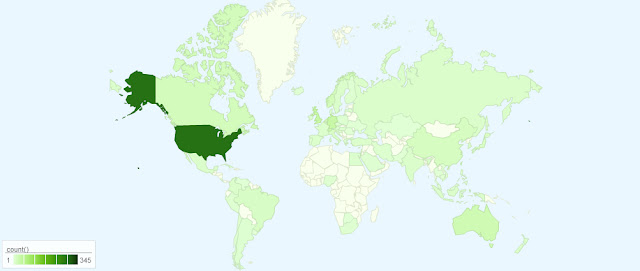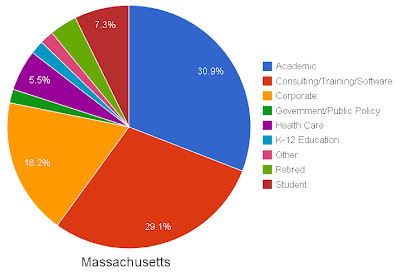0. How many SD professionals are there?
Its difficult to estimate the number of people involved in System Dynamics. My data set includes 901 points, and the SD LinkedIn group has 867 members as of last count. I haven't had a chance yet to analyze the overlap, although it is probably significant. There are also likely to be folks who are using SD in their careers or just casually on the weekend (ahem...) who don't show up in that sample. Either way - it's not a huge field.
1. Where is SD being practiced, geographically?
The US dominates SD practice globally with 38% of all practitioners, followed by the UK, Germany, and Switzerland. (Click images for a larger view)
Because the US is such a dominating fraction, the above map gives a poor representation of SD practitioners in other countries. If we exclude the US, its a bit easier to see comparisons between other countries.
Within the US, Massachusetts, New York, Texas, California, and Virginia lead the way:
While Texas, California and New York are high in the list partly due to their size, Massachusetts and Virginia (Washington DC, really) show some actual density:
Naturally we expect Massachusetts to be heavy on Academics, and Virginia to have a significant fraction of practitioners involved in Government or Military. I'm surprised, however, by the number of private sector practitioners in MA (possibly finding work coming out of Academia) and the educational emphasis of VA (perhaps where all the Gov't practitioners studied).
2. What Sectors do SD practitioners work in?
The academic sector dominates the worldwide SD practice with 54% of data points involved in either academic study or teaching at the university level. The private sector takes ~29% through consulting and corporate practitioners, although some of those may consult for other sectors. Approximately 8% are involved in the public sector or military, and another 5% in service of Health Care or Education.3. What organizations employ SD practitioners?
Of the top 20 employers of SD practitioners, 13 are universities:
Especially striking to me, however, is the fact that these 20 largest organizations only employ a total of 125 people out of the full data set of 901. Plotting the quantity of institutions with a certain number of practitioners, it becomes apparent that the vast majority of SD practitioners are working in small teams:
And that 84 percent of SD practitioners are the only SD person on their team:
This is really quite surprising to me, and raises a number of questions: Who does the average SD practitioner go to for help or a second opinion? How many of these are sole proprietorships? Is there not enough of a market to sustain multiple SD practitioners at an institution? How many of these actually use SD on a regular basis? Why aren't more SD practitioners joining forces to create joint ventures?
(There is another explanation, of course, which is that there are loads of SD practitioners who borrow the System Dynamics Review from their one friend at work who's a member of the society...)
These particular charts seem to be giving some advice: if you want to do SD with other SD people, you probably need to do it in an academic setting.
5. What roles do SD practitioners take in their institutions?
SD practitioners self-describe their roles in 70-odd categories, the top 20 of which are shown here:
The set of positions fall roughly into five categories:
It seems the odds are good for SD practitioners taking on leadership roles, although we should take it with a grain of salt considering our earlier research on group size.
6. What qualifications do SD practitioners have?
Based upon their 'Salutations', I would estimate that approximately 42 % of data points have Doctorate degrees, and the remaining with an unknown mix of High School Diplomas, Bachelors, or Masters Degrees.
Its interesting to see how those qualifications match up with sector. This chart shows that consultants may have a stronger link with non-PhD holders than with either Profs or Docs.
7. Questions for another day
I'd like to see if I can get some data on how SD practitioners work together and with folks outside the field, and understand how publication activity has changed over time at various institutions. It would be interesting to chart the rise and fall of active areas of research over time. I'd like to work out what SD practitioners are doing in addition to SD. Also, I'd like to work out how to use the interactive version of these charts while keeping individual data private!





